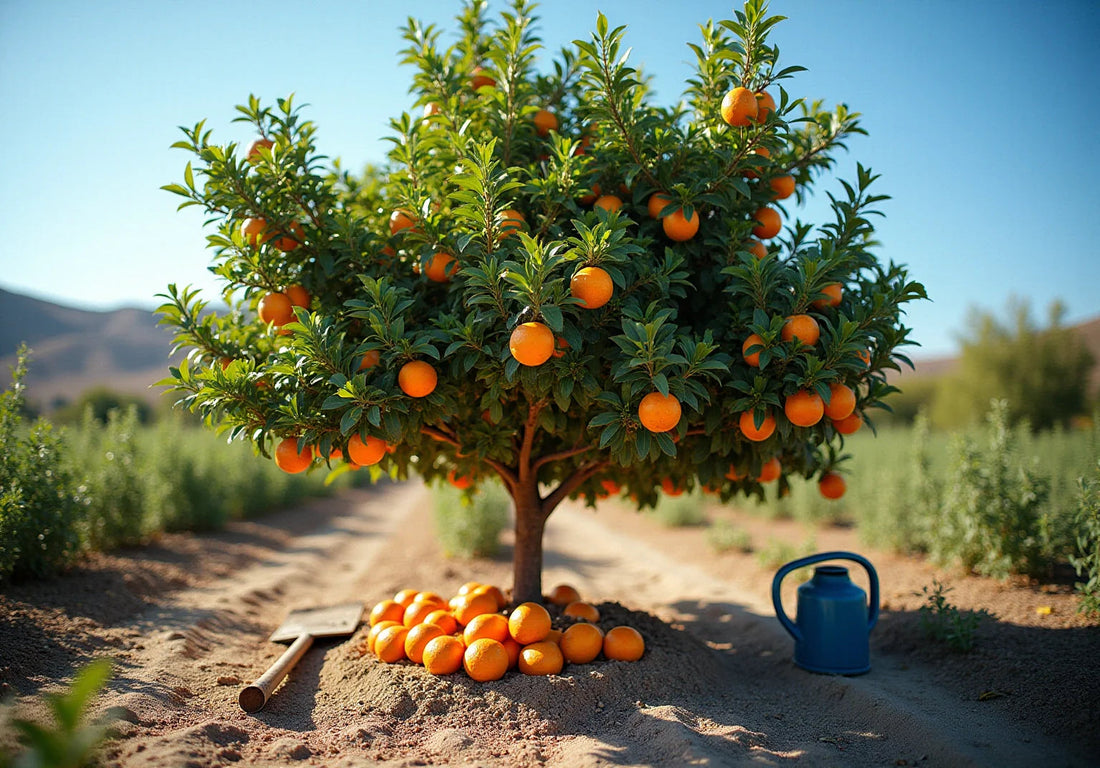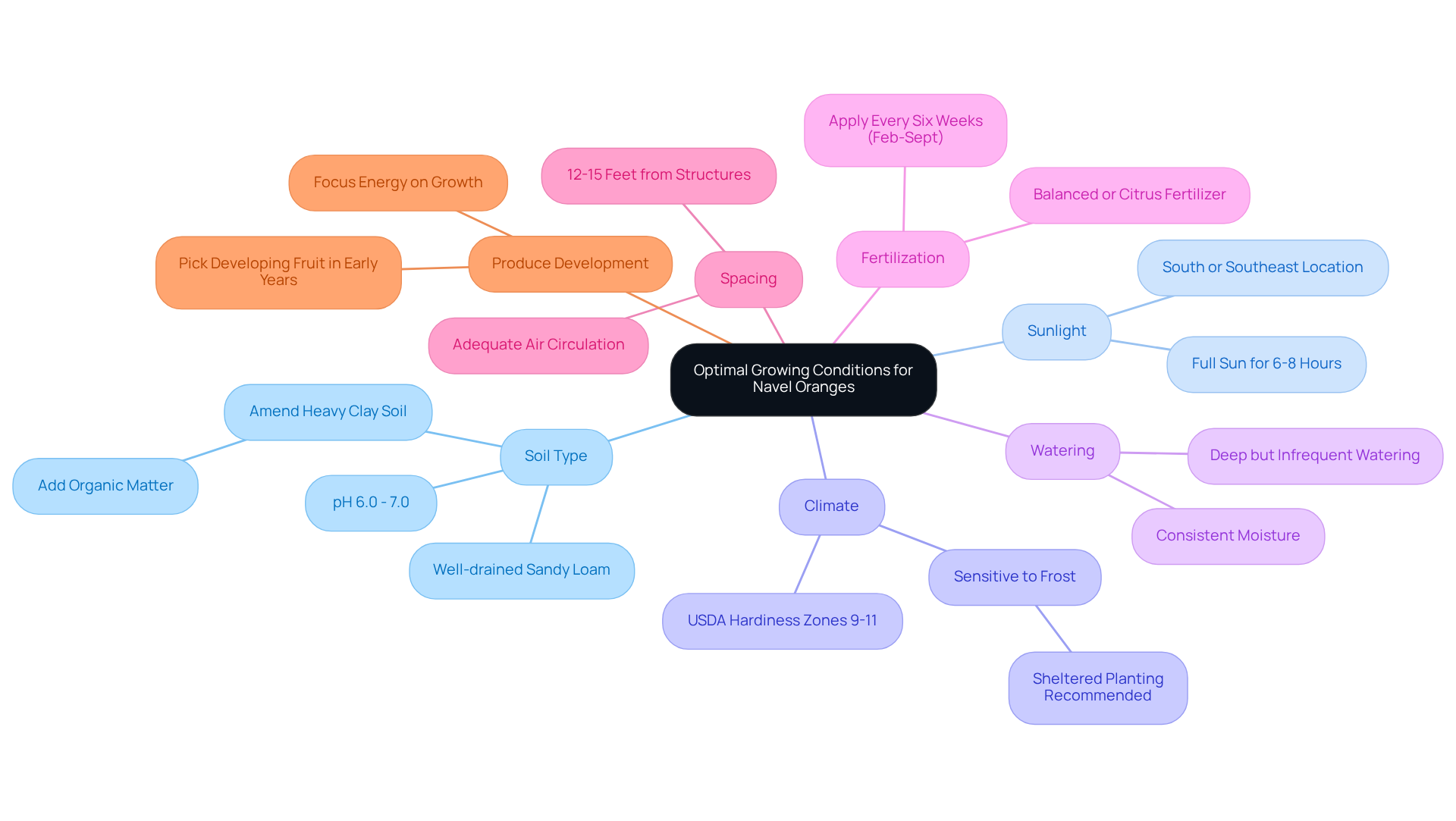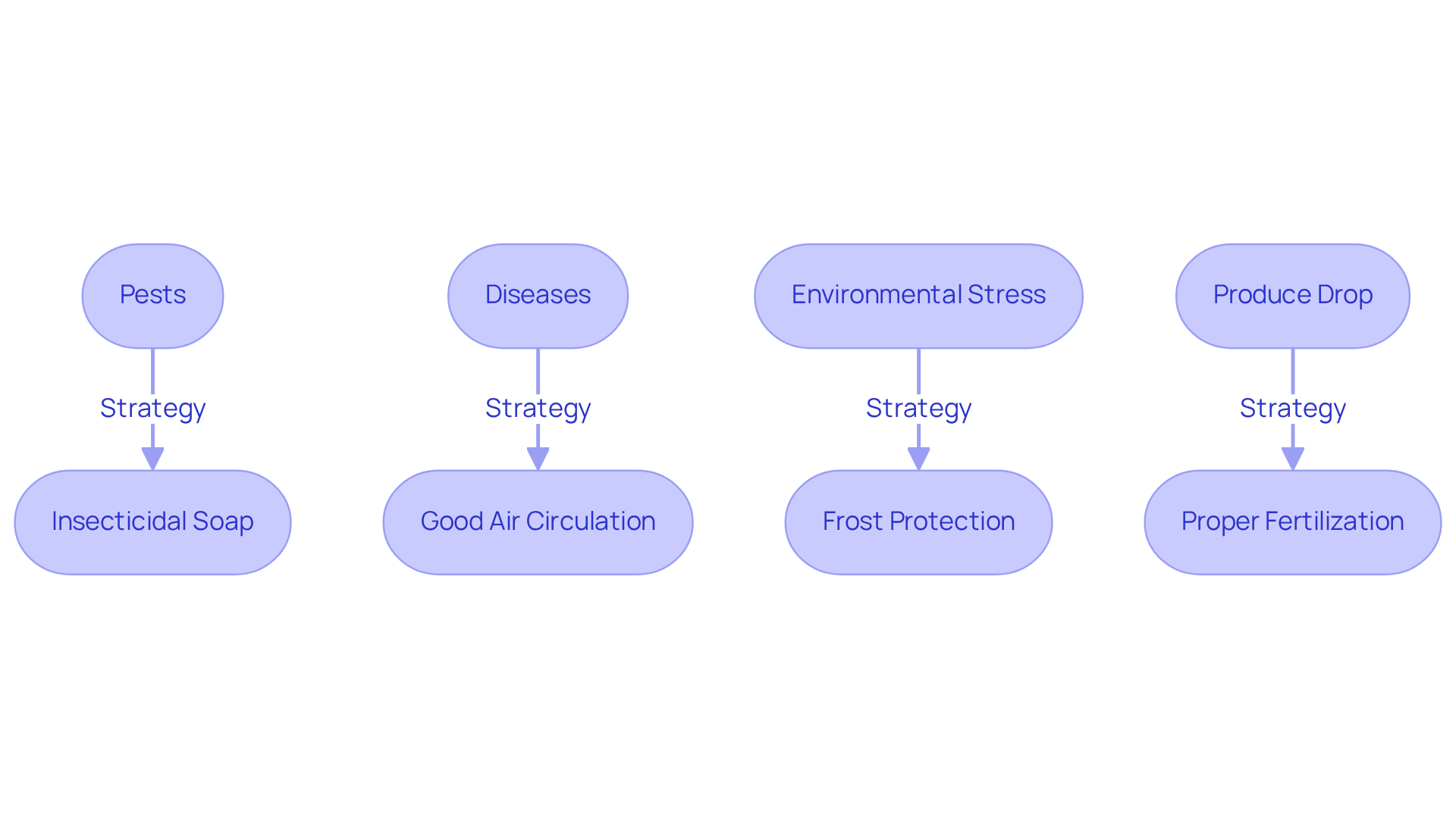
Master Navel Oranges: Key Strategies for Successful Cultivation
Share
Cultivating navel oranges can be a rewarding endeavor, yet it requires a keen understanding of specific growing conditions and care practices. By mastering essential strategies for successful cultivation—from soil composition to pest management—gardeners can unlock the full potential of these vibrant fruits. However, this journey is not without its challenges.
How can one effectively navigate the complexities of nurturing these delicate trees while ensuring a bountiful harvest? This article aims to provide insights and practical tips to support your cultivation efforts.
1. Establish Optimal Growing Conditions for Navel Oranges
To cultivate navel oranges successfully, it is crucial to establish optimal growing conditions. Key factors to consider include:
-
Soil Type: Navel fruits flourish in well-drained, sandy loam soils with a pH between 6.0 and 7.0. For those with heavy clay soil, it is advisable to amend it with organic matter to enhance drainage and aeration, ensuring the roots can access necessary nutrients.
-
Sunlight: Select a location that receives full sun for at least 6 to 8 hours daily, ideally on the south or southeast side of a house for protection from wind and cold. This sunlight exposure is vital for photosynthesis and the overall development of the fruit.
-
Climate: Navel fruits prefer warm conditions, ideally suited for USDA hardiness zones 9 to 11. While they can withstand brief cold spells, they are sensitive to frost. Therefore, planting them in a sheltered area is recommended for those in cooler zones.
-
Watering: Consistent moisture is essential, particularly during the first growing season. Water deeply but infrequently to promote deep root growth, allowing the soil to dry slightly between waterings.
-
Fertilization: Navel oranges plants should be well-nourished from March to August. A balanced or citrus fertilizer should be applied every six weeks from February to September to promote healthy growth and yield.
-
Spacing: When planting citrus trees, ensure there is at least 12 to 15 feet of distance from buildings, paths, and pavements to prevent overcrowding and allow for adequate air circulation.
-
Produce Development: In the initial years, it is advisable to gather developing produce to ensure that the plant concentrates its energy on growth instead of produce production.
By concentrating on these factors, gardeners can cultivate a setting that promotes healthy citrus plants, resulting in plentiful fruit yield.

2. Implement Effective Care Practices for Navel Oranges
Implementing effective care practices is essential for the health and productivity of citrus plants. This section outlines key strategies to ensure optimal growth:
-
Watering your navel orange plant should involve deeply hydrating it once a week during the growing season, making sure the soil stays moist but not soggy to prevent root rot. As the seasons shift, lessen watering in the autumn and winter months to align with the plant's dormancy.
-
Fertilizing: Utilize a balanced fertilizer specifically formulated for citrus plants, applying it every 2 to 3 months for mature specimens. For young plants, begin monthly feeding about six weeks after planting. This regular feeding provides the necessary nutrients for robust growth and fruitful production. Consider conducting leaf analysis to detect any nutritional deficiencies and adjust your fertilization program accordingly.
-
Pruning: Conduct pruning in late winter or early spring before new growth begins. Focus on eliminating dead, damaged, or diseased branches to enhance air circulation and light penetration, which are vital for plant health.
-
Mulching: Apply a 2-3 inch layer of organic mulch around the base of the plant. This practice aids in conserving moisture, suppressing weeds, and regulating soil temperature, creating a favorable environment for growth.
By adhering to these care practices, gardeners can sustain the health and productivity of their citrus plants, such as navel oranges, ultimately resulting in a plentiful harvest. Additionally, exercise caution against over-fertilization and ensure proper watering techniques to avoid common pitfalls.

3. Address Common Challenges in Navel Orange Cultivation
Growing citrus fruits presents several challenges that require careful management. Common issues and effective strategies to address them include the following:
-
Pests: Citrus plants are vulnerable to insects such as aphids, spider mites, and the orangeworm. Regular inspections are crucial for early detection of infestations. Employing insecticidal soap or neem oil serves as both a preventive measure and a treatment for any identified pests. Notably, recent studies indicate that models like DCPSNET have achieved an impressive accuracy of 96.90% in identifying various diseases and pests affecting navel oranges, underscoring the importance of timely intervention.
-
Diseases: Conditions such as citrus canker and root rot can significantly affect the health of plants. To reduce disease risk, ensure good air circulation around the plant and avoid overhead watering. If symptoms appear, promptly remove affected leaves and apply suitable fungicides as needed. As Stephen Devadoss observes, the U.S. citrus sector encounters significant difficulties from diseases, which can jeopardize the health of your plants.
-
Environmental stress can affect navel oranges due to extreme temperatures or inconsistent watering. Shield your plants from frost by covering them during cold spells, and uphold a regular watering routine to avoid drought stress. The reliance on guest workers in the citrus industry has increased due to labor shortages, making effective management practices even more critical for home gardeners.
-
Produce Drop: Premature produce drop may suggest stress or nutrient deficiencies. Applying appropriate fertilization and irrigation techniques can promote crop retention and overall plant health. Case studies have shown that proper nutrient management can significantly reduce fruit drop and enhance overall yield.
By proactively addressing these challenges and utilizing effective management strategies, gardeners can significantly enhance the resilience and productivity of their navel oranges.

Conclusion
Successfully cultivating navel oranges necessitates a thorough understanding of their specific growing needs and effective care practices. By establishing optimal conditions—such as the right soil, sunlight, and climate—gardeners can foster an environment that promotes healthy growth and abundant fruit production.
Key strategies include:
- Employing proper watering techniques
- Regular fertilization
- Vigilant management of pests and diseases
These practices are essential for sustaining the health and productivity of navel orange trees. Proactively addressing common challenges, such as environmental stress and premature fruit drop, ensures that these trees thrive and yield a bountiful harvest.
Ultimately, mastering the cultivation of navel oranges not only enhances the gardening experience but also contributes to sustainable practices in fruit production. By applying the insights and techniques discussed, cultivators can reap the rewards of their efforts, leading to a fruitful and fulfilling gardening journey.
🍊 Grow Your Own Navel Oranges Today!
Start your gardening journey with Everglades Farm and enjoy a bountiful harvest of delicious fruit.
🛒 Buy Navel Orange Tree
🛒 Explore Orange Trees Collection
🛒 Explore Citrus Trees
Frequently Asked Questions
What type of soil is best for growing navel oranges?
Navel oranges thrive in well-drained, sandy loam soils with a pH between 6.0 and 7.0. If the soil is heavy clay, it is recommended to amend it with organic matter to improve drainage and aeration.
How much sunlight do navel oranges need?
Navel oranges require full sun for at least 6 to 8 hours daily. It is ideal to plant them on the south or southeast side of a house for protection from wind and cold.
What climate is suitable for growing navel oranges?
Navel oranges prefer warm conditions and are best suited for USDA hardiness zones 9 to 11. They can tolerate brief cold spells but are sensitive to frost, so planting in a sheltered area is advisable in cooler zones.
How should navel oranges be watered?
Navel oranges need consistent moisture, especially during the first growing season. It is best to water deeply but infrequently, allowing the soil to dry slightly between waterings to promote deep root growth.
What fertilization schedule is recommended for navel oranges?
Navel oranges should be well-nourished from March to August. A balanced or citrus fertilizer should be applied every six weeks from February to September to support healthy growth and yield.
How far apart should navel orange trees be planted?
When planting navel orange trees, ensure they are spaced at least 12 to 15 feet away from buildings, paths, and pavements to prevent overcrowding and allow for adequate air circulation.
Should developing fruit be left on the tree in the initial years?
In the initial years, it is advisable to gather developing produce to allow the plant to concentrate its energy on growth rather than fruit production.

